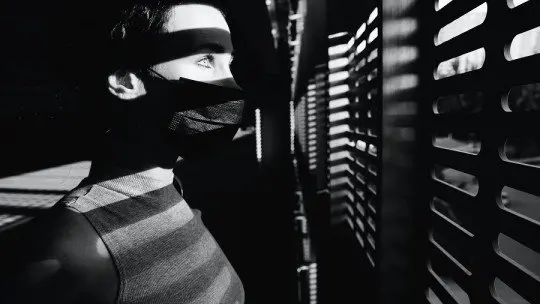
In the nineties one of the first films appeared in which A case of agoraphobia. The psychologist who stars in this piece of fiction feels anxious just by leaving her apartment for a few seconds to reach the newspaper.
Of course, and as striking as the scene may seem, It is still a resource to introduce one of the main characters. It does not serve to understand what this anxiety disorder consists of, but rather it confronts us with an extreme case of agoraphobia so that we can see to what extent it can put a person’s quality of life to the limit and understand that person’s behavior. At the same time, it demonstrates the fact that the anxiety crises produced by this disorder can be very impactful and be present in many spheres of a human being’s life.
But, although agoraphobia is so shocking and its consequences can be so palpable, it cannot be said that it is easy to understand what it consists of. Read what comes next can help when forming a more detailed image of this type of phobiaand at the same time know its main symptoms, causes and ways to treat agoraphobia.
Agoraphobia, fear of open spaces?
It is usually assumed that agoraphobia consists of an irrational fear of open spaces, such as large avenues, parks or natural environments. The etymology of the word itself suggests a relationship between phobia and the squares (agorasa word from the Greek), and it is easy to take for agoraphobia certain cases of people who simply do not like to leave the house or with problems related to social isolation.
However, It is not entirely true that agoraphobia is equivalent to the fear of open or public spaces.. It is a way of feeling fear and anguish whose origin is something more abstract than the simple visualization of this type of environment.
The fact of perceiving open or crowded spaces plays a role in triggering panic attacks in people with agoraphobia, but the fear is not produced by these spaces per se, but rather by for the consequences of being exposed to that place. This nuance is key and is often overlooked.
So… what is agoraphobia? Definition
A first superficial approach to the concept of agoraphobia consists of defining it as an anxiety disorder that is expressed by noticing that you are not in a safe context in which it is possible to receive help in a crisis. That is to say, its symptoms are based on strong anguish produced by situations in which the person suffering from it feels unprotected and vulnerable to anxiety crises that are beyond their control. The root of the problem is something like a fear of fear. And that means that once you have entered into the dynamic of fearing the symptoms of agoraphobia, this favors its appearance. It is a disorder that is often based on self-fulfilling prophecy, or a whiting that bites its tail linked to fear and anxiety.
The distressing fear that someone with this anxiety disorder experiences is basically based on anticipation of panic attacks. Therefore, where there is agoraphobia there is also a fear-based loop. A vicious cycle of recurring thoughts that is difficult to escape.
In some way, agoraphobia feeds itself through the anticipation of both the unpleasant sensations associated with these crises and the dangers that come with losing control over one’s actions. Therefore, the way in which this feeling of anxiety is expressed also reproduces the structure of a loop: one fears not the open space, but the possibility of suffering a panic attack or an anxiety crisis by being there, and at the same time the consequences of being in that place when that happens.
In short, agoraphobia is the fear of losing control about one’s own physiological activation and the results to which this can lead, in addition to the fear of the subjective sensations of discomfort that this would produce in real time. This is what explains why anxiety attacks can appear not only in large spaces, but also in an elevator or any place other than your own home. Agoraphobia usually expresses itself in any place that is perceived as especially unsafe, that is, where we have less control over things.

The myth of agoraphobia as a watertight compartment
From what has been said above we can reach a conclusion: The symptoms of agoraphobia are not always the same, and its triggers can have very different forms.. The situations and places that can produce anguish or anxiety are neither stereotypical nor the same in all people diagnosed with this disorder, as would be expected if agoraphobia were expressed in a similar way to how fear of animals is expressed in popular culture. vampires to crucifixes. In fact, it sometimes happens that anxiety attacks occur even when the person is in a “safe” place, due to internal causes unrelated to how the environment is perceived.
Because of this variability, it is common for people with agoraphobia to also be diagnosed with other disorders, such as panic disorder or post-traumatic stress disorder, since several of their symptoms can overlap. As we see, there are common confusions about the symptoms and signs of this psychological disorder.
Diagnosis and symptoms
Broadly speaking, some of the characteristics that people with agoraphobia present are:
It is very important to highlight the fact that this information is only indicative and that Only a specialist can diagnose case by case when there is a case of agoraphobia and when there is not..
When diagnosing this type of disorder, it is essential to take into account whether the person perceives what is happening to them as something that limits their quality of life and is, therefore, disabling. That is to say, the existence or not of agoraphobia does not depend only on the symptoms, but also on the context in which they occur, both subjectively (does the patient think it is problematic?) and objectively (do the symptoms appear when Is anxiety unjustified?
That is why we must consider to what extent any person without anxiety problems can present to a greater or lesser extent any of these general characteristics associated with agoraphobia.
Causes
It is one thing to describe a disorder, and quite another to talk about its causes.. Regarding this, it is common to believe that phobias in general, including agoraphobia, appear simply because of a stressful lifestyle, or that they are the expression of some type of trauma or internal conflict that is expressed symbolically through of fear of open spaces.
However, currently these types of explanations are not very useful (and in the case of the second it cannot even be demonstrated by the epistemological foundations of this approach), among other things because they ignore possible organic causes. That is, those that have to do with the biological functions that determine our thoughts and our moods.
Although it is true that It is not known what exactly causes agoraphobia.a link has been detected between this type of disorder and abnormally low serotonin levels in certain parts of the brain. These low levels of serotonin can be caused by a genetic mutation, but they can also be due to a chemical decompensation caused by certain experiences or the consumption of certain substances, or they can be the product of all of this at the same time.
Regardless of whether this finding ends up being correct or not in explaining the mechanisms behind this disorder, what is clear is that there is no single cause of agoraphobia, but several, as occurs in practically any psychological phenomenon, pathological or not.
Agoraphobia appears and is expressed through biological and genetic factors, but also cultural and based on the learning that each person has carried out and that constitutes their memories. Psychologically, human beings are bio-psycho-social in nature, and the same goes for mental disorders.
Treatment
Once diagnosed, agoraphobia It can be treated both through psychological intervention and through drugs.. Below we will see what these two types of treatment for agoraphobia are, but it is important to emphasize that only a mental health professional is authorized to carry out effective therapy.
1. Drug treatment
In pharmacological treatment, both antidepressants (SSRI) as anxiolytics (clonazepam and diazepam). However, these medications should only be taken under strict medical supervision and only with a prescription, and in any case they are not used to cure the disorder, but to cope with its symptoms.
It is also important to keep in mind that, as always happens with drugs, they can produce important side and adverse effects, such as the appearance of serotonin syndrome. This occurs because, as with all drugs in general, those used to combat the symptoms of phobias not only act on the parts of the brain involved in keeping the level of anxiety high, but also impact the entire body in general. , and this can cause a mismatch depending on the genetic and biological predispositions of the individual.
Therefore, there is always a certain risk when using these substances, whether against agoraphobia or against any other psychological disorder, and it is the task of mental health professionals to determine if the danger is low enough to use a certain dose, and what way it should be used.
2. Psychological therapy
Regarding the psychotherapeutic approach, interventions based on Cognitive-Behavioral Therapy stand out. It is a type of therapy whose benefits have been scientifically proven.
The advantages of this option are that Its benefits tend to last longer over time than the effects of drugs. After the last doses, it is a brief intervention and has no side effects as it does not act directly on the regulation of hormones and neurotransmitters.
Among its drawbacks compared to pharmacological treatment are the relative slowness with which progress appears and the need for the person with agoraphobia to be in a position to collaborate and achieve the objectives proposed in the therapy. This is important, because progress with these types of interventions It means making an effort and facing unpleasant situations to generate greater resistance to what is feared, with professional supervision and in a controlled environment.
From the Cognitive-Behavioral perspective, we will work both on the beliefs that the person has about their disorder and on their daily habits and actions, so that the changes carried out in both dimensions, the mental and the behavioral, reinforce each other. In addition, it is also common to resort to relaxation techniques to train the ability to manage anxiety.
In many cases It will be recommended to use pharmacological and psychological intervention at the same time.to alleviate the immediate effects of this anxiety disorder and at the same time train the patient to be able to expose themselves more and more to feared situations and manage the feeling of nervousness. However, this will only occur if it is considered strictly necessary, and the drugs should only be consumed under medical indication.








